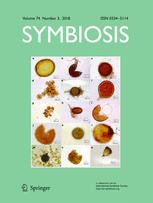Ver ítem
- xmlui.general.dspace_homeCentros e Institutos de InvestigaciónCICVyA. Centro de Investigación en Ciencias Veterinarias y AgronómicasInstituto de Microbiología y Zoología AgrícolaArtículos científicosxmlui.ArtifactBrowser.ItemViewer.trail
- Inicio
- Centros e Institutos de Investigación
- CICVyA. Centro de Investigación en Ciencias Veterinarias y Agronómicas
- Instituto de Microbiología y Zoología Agrícola
- Artículos científicos
- Ver ítem
The benefits of foliar inoculation with Azospirillum brasilense in soybean are explained by an auxin signaling model
Resumen
Azospirillum sp. is one of the most studied genera of plant growth-promoting rhizobacteria (PGPR). The ability of Azospirillum sp. to promote plant growth has been associated with its ability to produce several phytohormones, such as auxins, gibberellins and cytokinins, but mainly indole-3-acetic acid (IAA). It has been propoosed that the production of IAA explains the positive effects of co-inoculation with Azospirillum sp. on the rhizobia-legume
[ver mas...]
Azospirillum sp. is one of the most studied genera of plant growth-promoting rhizobacteria (PGPR). The ability of Azospirillum sp. to promote plant growth has been associated with its ability to produce several phytohormones, such as auxins, gibberellins and cytokinins, but mainly indole-3-acetic acid (IAA). It has been propoosed that the production of IAA explains the positive effects of co-inoculation with Azospirillum sp. on the rhizobia-legume symbiosis. In this study, we constructed an IAA-deficient mutant of A. brasilense Az39 (ipdC−) by using a restriction-free cloning method. We inoculated soybean seeds with 1·106 cfu·seed−1 of
Bradyrhizobium japonicum E109 and co-inoculating leaves at the V3 stage with 1·108 cfu.plant−1 of A. brasilense Az39 wt or ipdC− or inoculated leaves with 20 μg.plant−1 synthetic IAA. The results confirmed soybean growth promotion as there was increased
total plant and root length, aerial and root dry weight, number of nodules on the primary root, and an increase in the symbiosis established with B. japonicum E109. Nodule weight also increased after foliar co-inoculation with the IAA- producer A. brasilense Az39. The exogenous application of IAA decreased aerial and root length, as well as the number of nodules on primary roots in comparison with the Az39 wt strain. These results allow us to propose a biological model of response to foliar co-inoculation of soybean with IAA-producing rhizobacteria. This model clearly shows that both the presence of microorganism as part of the colonization process and the production of IAA in situ are co-responsible, via plant signaling molecules, for the positive effects on plant growth and symbiosis establishment.
[Cerrar]

Fuente
Symbiosis 76 (1) : 41–49 (September 2018)
Fecha
2018-09
ISSN
0334-5114
1878-7665
1878-7665
Formato
pdf
Tipo de documento
article
Palabras Claves
Derechos de acceso
Restringido
 Excepto donde se diga explicitamente, este item se publica bajo la siguiente descripción: Creative Commons Attribution-NonCommercial-ShareAlike 2.5 Unported (CC BY-NC-SA 2.5)
Excepto donde se diga explicitamente, este item se publica bajo la siguiente descripción: Creative Commons Attribution-NonCommercial-ShareAlike 2.5 Unported (CC BY-NC-SA 2.5)

